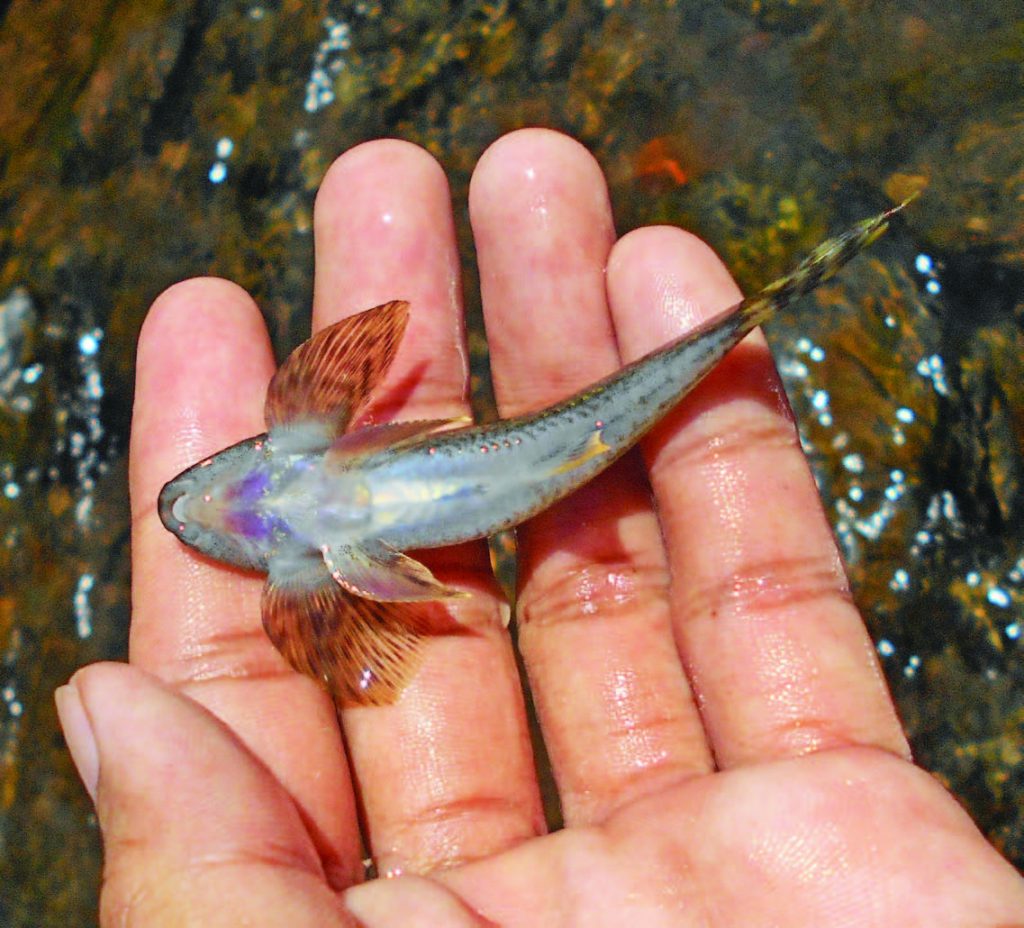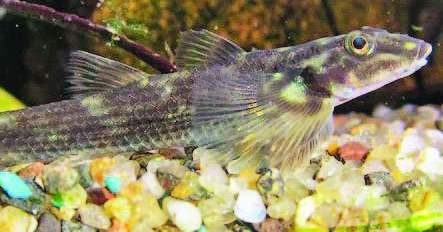Anyone familiar with the freshwater fish fauna of the Philippines surely would have noticed that the dominant group is comprised of the gobies, which is divided in two families: the Eleotridae and the Gobiidae. The eleotrids are commonly called “sleeper gobies”, while the latter comprises the true gobies, or those with ventral fins fused to form a suction cup called the pelvic sucker.
The eleotrids are mostly predatory while the true gobies include carnivorous, detritivorous, omnivorous, and herbivorous species. A widespread but not often observed goby in freshwater areas is Rhyacichthys. The two species of Rhyacichthys are called loach gobies due to their resemblance to hillstream loaches from the family Balitoridae and Gastromyzontidae.

Since this family is not found in the Philippines, Rhyacichthys fills an ecological niche that is otherwise filled by hillstream loaches elsewhere.
Historical records and distribution
Rhyacichthys aspro was originally described from Bantam, in western Java, and subsequently found in Sulawesi and the Solomon Islands. The German naturalist Feodor Jagor collected it in Loquilocon in Samar, while Adolf Bernhard Meyer scientifically collected the species in Luzon, with the locality specified as “Bahia de Manila”, which is most likely an error due to the fact that Manila Bay is saline, while the species in question is decidedly freshwater.
This loach goby appears to be found in all the larger islands of the Philippines (and smaller ones as well). In May 2011, renowned German aquarist Heiko Bleher collected what appeared to be a different, undescribed species in Oriental Mindoro.
Man vs Goby
Due to their life cycle, catadromous fishes are severely affected by the construction of dams, including the controversial Kaliwa Dam, which cut off migratory routes resulting in localized extinctions.
To this day, I am still not aware of any successful captive reproduction of catadromous species. Hence, endemic fish fauna face real possibilities of annihilation when dams are built without any consideration of how the surrounding habitat will be altered in the process.
Description
The loach goby is a medium-sized species usually attaining a total length of about 15 centimeters. The body is distinctly flattened, evoking the very familiar plecos we know so very well in the aquarium hobby.

In contrast to the armored catfishes, R. aspro possesses greatly enlarged pectoral fins which has been likened to those featured on scorpionfishes. Observation of these fishes in the wild suggest that the pectoral fins are adjusted by the fishes in much the same way as the airplane wing flaps are used to provide lift and drag. In turbulent waters, the pectorals are pressed to the substrate to shut off the flow of water underneath the body and facilitate the passage of water above the dorsum, thereby reducing drag and eliminating the possibility of the fish being forcefully lifted due to the effects of water gushing beneath the body.
This shutting off of the pectorals is made even more effective by the overlapping ventral fins. These, combined with the low profile and the pelvic sucker, allow for a highly hydrodynamically equipped fish suitable to fast-flowing rivers and streams.
In these habitats, movement is not the problem for fishes, as the current is strong enough to carry them from one spot to another. The difficulty here is staying still. The pelvic suckers and the pectoral fins afford stability while the latter additionally provide steering.
Sicyopus, which also possess enlarged pectoral fins though to a lesser extent, can be found in fast-flowing waters, but more so in deeper and calmer waters.
Loach goby coloration can best be described as “cryptic”, consisting of a grayish-brown to yellowish ground color marked with transverse, irregularly bordered black bands, with the top of the head being overlaid with dark coloration; the ground coloration turns into pale green perhaps depending on mood, but most often observed at night. The undersides are unmarked.
This suggests that possible predators are most likely wading birds, which use visual cues to hunt for food. The coloration and patterning of loach gobies likely protect them from most overhead attacks.
Observations gleaned from aquarium specimens revealed that during tank maintenance, especially water changes, Rhyacichthys is less apt to flee and look for cover compared to other fishes, staying in its resting spot even when the siphon tube is practically next to its body.
Another cryptically colored gobiid, the extremely predatory Glossogobius giuris, or the common biya, also stays motionless despite nearby disturbance. This suggests that in the presence of larger animals, such gobies further enhance their camouflage by staying still.
Like many freshwater gobies, Rhyacichthys is catadromous, with the adults spawning at river mouths. The eggs are carried off to the sea where they hatch as larvae, before swimming back to the river to reach adulthood.
Habitat and behavior
These fishes are found in fast-flowing bodies of water with little or no submersed vegetation, although they have also been recorded in placid lakes, such as the historical record mentioned above, which likely came from the town of Sta. Cruz in Laguna. The population is surely already extinct due to the pollution of the said lake and the proliferation of non-native fishes, notably tilapia, snakeheads (dalag), and hito (Clarias batrachus and the so-called African hito, C. gariepinus)*.
(*There is only one hito species that is native to the Philippines, thebighead catfish (Clarias macrocephalus). This rare species is already at risk of extinction due to their localized ranges and dilution of genes from hybridization events with non-native Clarias species, particularly C. batrachus.The other Clarias species, C. nieuhoffii, is locally known as pantat; some Philippine populations appear sufficiently distinct from that species to possibly warrant independent specific status.)
The loach goby typically stays around boulders and large rocks, often congregating in small numbers. When sufficiently disturbed, they dart around the rocks and attempt to hide underneath or in available crevices.
However, observations oF captive specimens suggest that these gobies rely on their cryptic coloration to avoid being detected. As such, they usually stay motionless, confident that they are not seen at all. Or perhaps this seeming complacency reflects to them being one of the lesser favored food items of predatory fishes, such as the rapacious Glossogobius giuris and Giuris margaritacea, as well as the larger eels, notably the casili (Anguilla marmoratus). The bony exterior and the strong grip of loach gobies on the substrate probably requires more energy investment from potential predators, and it might be much more economical, effort-wise, to hunt down softer-bodied prey instead.
Rhyacichthys usually coexist with gobies from other genera such as Awaous, Glossogobius, Redigobius, Rhinogobius, Sicyopterus, Sicyopus, and Stiphodon; eleotrids such as Bunaka, Eleotris and Oxyeleotris; the widespread cyprinid Puntius binotatus; Kuhlia species; freshwater pipefishes including Doryichthys and Microphis; the snake eel Lamnostoma; as well as various genera of shrimps, notably Atyopsis, Caridina, and Macrobrachium. However, many of their habitats have already been contaminated by exotics such as poecilids and tilapia.
Food
Loach gobies feed primarily on algae and are frequently associated with other algae-eating gobiids, such as species of Sicyopus and Stiphodon. However, compared to these two genera, Rhyacichthys appears to avoid locations illuminated by direct sunlight. As might be expected from algae-grazing fishes, the diet may not be exclusively made up of roughage, as algae mats also support microscopic fauna. Thus, in a sense, algae eaters, including the loach goby, may also be construed as omnivorous.

In the aquarium, loach gobies are less frequently seen grazing on algae as compared to the more active Sicyopus. The somewhat lesser food requirements of Rhyacichthys may point to a lower metabolism.
Aquarium behavior
In aquarium situations, loach gobies seem to stay in spots that receive strong water flow, such as near power heads or filters. In this kind of setting, Rhyacichthys endear themselves to keepers because they always stay out in the open.
In my tank, for example, the algae-eating Sicyopus tend to quickly hide whereas Stiphodon atropurpureus display a well-defined activity time, and observing them is not possible by late noon. Rhyacichthys, in contrast, can be appreciated from sun up to sun down.
Loach gobies appear and behave very much like plecos and hillstream loaches, such as the popular Gastromyzon. However, Rhyacichthys is a fish that does not appear in dealers’ lists, so it’s unlikely that you’ll ever see one being offered for sale. Still, these fishes are sometimes caught as bycatch in more remote settlements, and if you happen upon some, you may as well ask the fishermen if you can have these instead.
This appeared in Animal Scene magazine’s July 2019 issue.
Related stories:
– Seeing red: Dominant red-colored fishes
– Very rare megamouth shark slaughtered in Cagayan de Oro after getting caught in fisherman’s net
– This fish turns gloomy when separated from its lover





